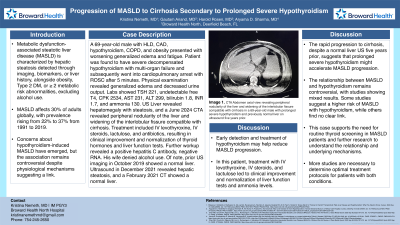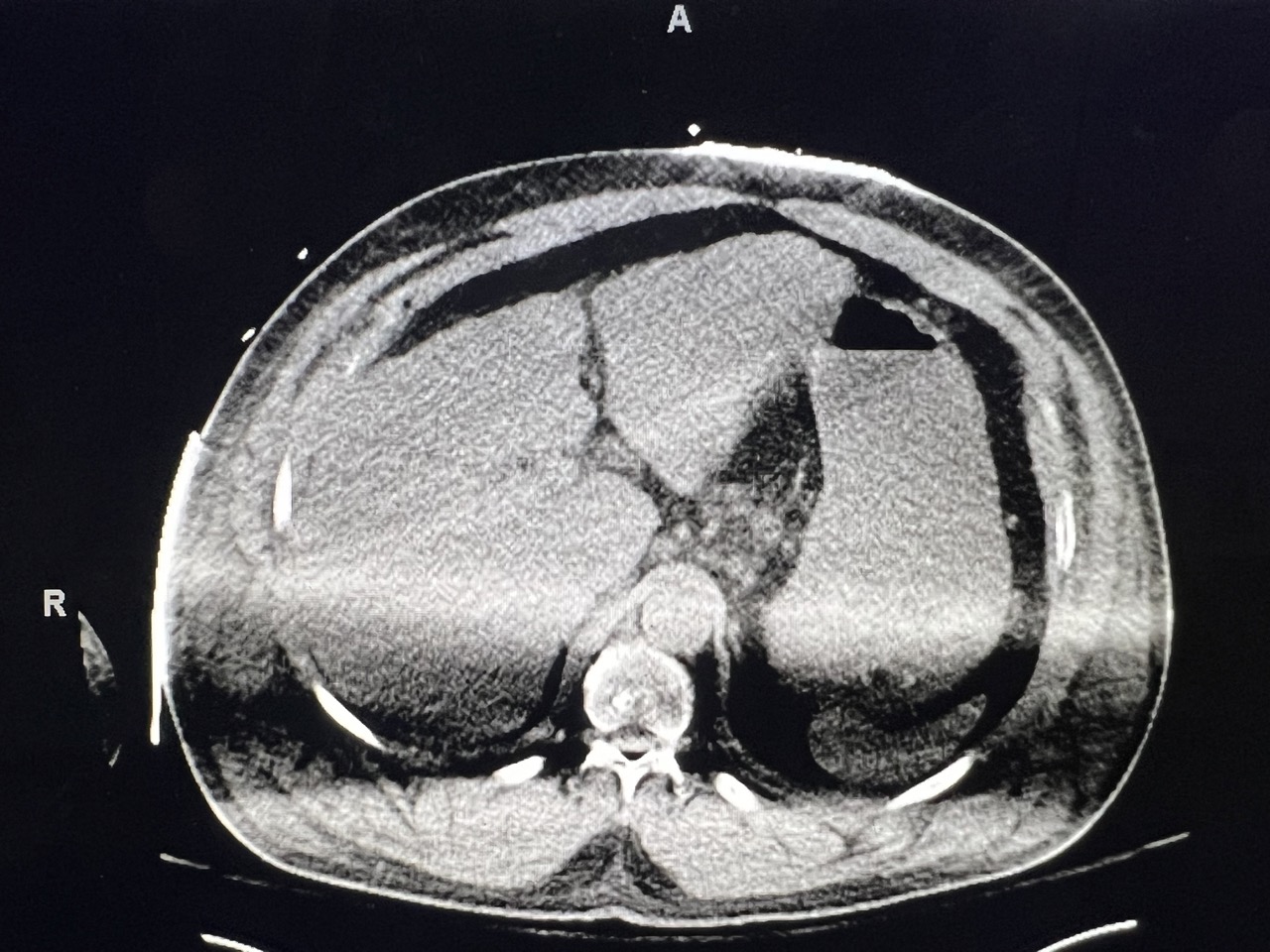Sunday Poster Session
Category: Liver
P1366 - Progression of MASLD to Cirrhosis Secondary to Prolonged Severe Hypothyroidism
Sunday, October 27, 2024
3:30 PM - 7:00 PM ET
Location: Exhibit Hall E

Has Audio

Kristina Nemeth, MD
Broward Health North
Coral Springs, FL
Presenting Author(s)
Kristina Nemeth, MD1, Anand Gautam, MD2, Harold Rosen, MD2
1Broward Health North, Coral Springs, FL; 2Broward Health North, Deerfield Beach, FL
Introduction: Metabolic dysfunction-associated steatotic liver disease (MASLD) is characterized by hepatic steatosis detected through imaging, biomarkers, or liver history, alongside obesity, Type 2 DM, or ≥ 2 metabolic risk abnormalities, excluding alcohol use. MASLD affects 30% of adults globally, with prevalence rising from 22% to 37% from 1991 to 2019. Concerns about hypothyroidism-induced MASLD have emerged, but the association remains controversial despite physiological mechanisms suggesting a link.
Case Description/Methods: A 69-year-old male with HLD, CAD, hypothyroidism, COPD, and obesity presented with worsening generalized edema and fatigue. Patient was found to have severe decompensated hypothyroidism with multi-organ failure and subsequently went into cardiopulmonary arrest with ROSC after 5 minutes. Physical examination revealed generalized edema and decreased urine output. Labs showed TSH 221, undetectable free T4, CPK 2534, AST 231, ALT 299, bilirubin 1.8, INR 1.7, and ammonia 130. US Liver revealed hepatomegaly with steatosis, and a June 2024 CTA revealed peripheral nodularity of the liver and widening of the interlobular fissure compatible with cirrhosis. Treatment included IV levothyroxine, IV steroids, lactulose, and antibiotics, resulting in clinical improvement and normalization of thyroid hormones and liver function tests. Further workup revealed a positive hepatitis C antibody. His wife denied alcohol use. Of note, prior imaging in October 2019 showed a normal liver. Ultrasound in December 2021 revealed hepatic steatosis, and a February 2021 CT showed a normal liver.
Discussion: Early detection and treatment of hypothyroidism may help reduce MASLD progression. In this patient, treatment with IV levothyroxine, IV steroids, and lactulose led to clinical improvement and better liver function tests and ammonia levels. The rapid progression to cirrhosis, despite a normal liver five years prior, suggests that prolonged severe hypothyroidism might accelerate MASLD progression. The association between MASLD and hypothyroidism remains controversial, with studies showing mixed results. Some studies suggest a higher risk of MASLD with hypothyroidism, while others find no clear link. This case supports the need for routine thyroid screening in MASLD patients and further research to understand the relationship and underlying mechanisms. More studies are necessary to determine optimal treatment protocols for patients with both conditions.

Disclosures:
Kristina Nemeth, MD1, Anand Gautam, MD2, Harold Rosen, MD2. P1366 - Progression of MASLD to Cirrhosis Secondary to Prolonged Severe Hypothyroidism, ACG 2024 Annual Scientific Meeting Abstracts. Philadelphia, PA: American College of Gastroenterology.
1Broward Health North, Coral Springs, FL; 2Broward Health North, Deerfield Beach, FL
Introduction: Metabolic dysfunction-associated steatotic liver disease (MASLD) is characterized by hepatic steatosis detected through imaging, biomarkers, or liver history, alongside obesity, Type 2 DM, or ≥ 2 metabolic risk abnormalities, excluding alcohol use. MASLD affects 30% of adults globally, with prevalence rising from 22% to 37% from 1991 to 2019. Concerns about hypothyroidism-induced MASLD have emerged, but the association remains controversial despite physiological mechanisms suggesting a link.
Case Description/Methods: A 69-year-old male with HLD, CAD, hypothyroidism, COPD, and obesity presented with worsening generalized edema and fatigue. Patient was found to have severe decompensated hypothyroidism with multi-organ failure and subsequently went into cardiopulmonary arrest with ROSC after 5 minutes. Physical examination revealed generalized edema and decreased urine output. Labs showed TSH 221, undetectable free T4, CPK 2534, AST 231, ALT 299, bilirubin 1.8, INR 1.7, and ammonia 130. US Liver revealed hepatomegaly with steatosis, and a June 2024 CTA revealed peripheral nodularity of the liver and widening of the interlobular fissure compatible with cirrhosis. Treatment included IV levothyroxine, IV steroids, lactulose, and antibiotics, resulting in clinical improvement and normalization of thyroid hormones and liver function tests. Further workup revealed a positive hepatitis C antibody. His wife denied alcohol use. Of note, prior imaging in October 2019 showed a normal liver. Ultrasound in December 2021 revealed hepatic steatosis, and a February 2021 CT showed a normal liver.
Discussion: Early detection and treatment of hypothyroidism may help reduce MASLD progression. In this patient, treatment with IV levothyroxine, IV steroids, and lactulose led to clinical improvement and better liver function tests and ammonia levels. The rapid progression to cirrhosis, despite a normal liver five years prior, suggests that prolonged severe hypothyroidism might accelerate MASLD progression. The association between MASLD and hypothyroidism remains controversial, with studies showing mixed results. Some studies suggest a higher risk of MASLD with hypothyroidism, while others find no clear link. This case supports the need for routine thyroid screening in MASLD patients and further research to understand the relationship and underlying mechanisms. More studies are necessary to determine optimal treatment protocols for patients with both conditions.

Figure: CT imaging revealing peripheral nodularity of the liver and widening of the interlobular fissure compatible with cirrhosis in a 69-year-old male with prolonged severe hypothyroidism and previously normal liver on ultrasound five years prior.
Disclosures:
Kristina Nemeth indicated no relevant financial relationships.
Anand Gautam indicated no relevant financial relationships.
Harold Rosen indicated no relevant financial relationships.
Kristina Nemeth, MD1, Anand Gautam, MD2, Harold Rosen, MD2. P1366 - Progression of MASLD to Cirrhosis Secondary to Prolonged Severe Hypothyroidism, ACG 2024 Annual Scientific Meeting Abstracts. Philadelphia, PA: American College of Gastroenterology.
